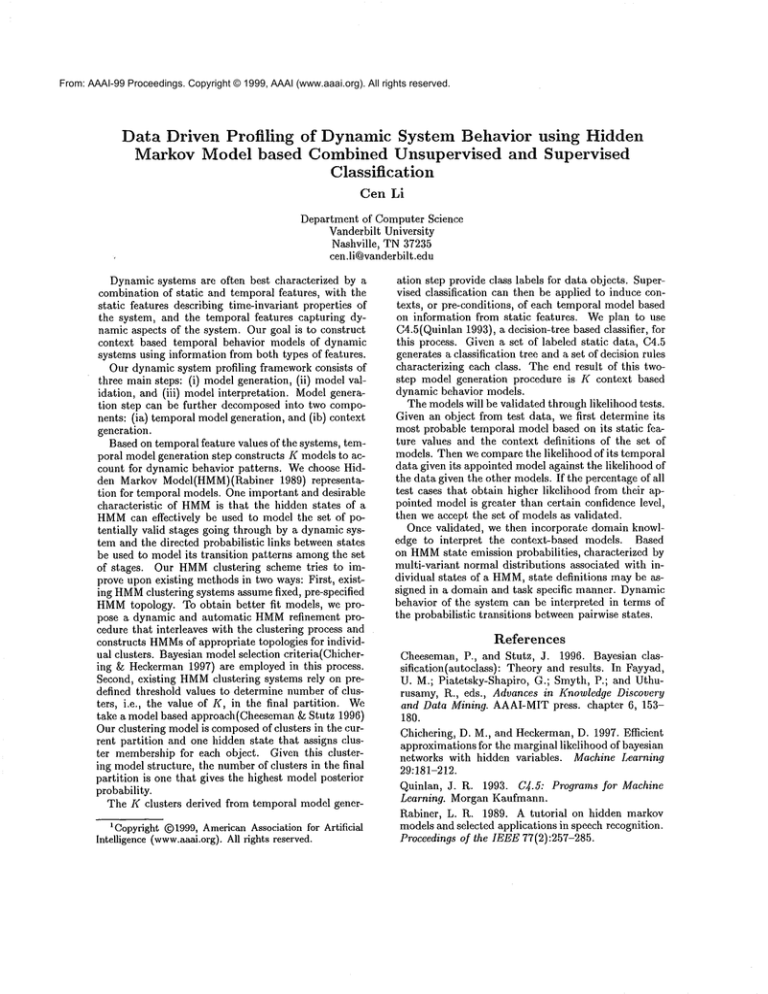Data Driven Profiling
advertisement

From: AAAI-99 Proceedings. Copyright © 1999, AAAI (www.aaai.org). All rights reserved. Data Driven Profiling of Dynamic System Behavior using Hidden Markov Model based Combined Unsupervised and Supervised Classification Cen Li Department of Computer Science Vanderbilt University Nashville, TN 37235 cen.li@vanderbilt.edu Dynamicsystems are often best characterized by a combination of static and temporal features, with the static features describing time-invariant properties of the system, and the temporal features capturing dynamic aspects of the system. Our goal is to construct context based temporal behavior models of dynamic systems using information from both types of features. Our dynamic system profiling framework consists of three main steps: (i) model generation, (ii) model idation, and (iii) model interpretation. Model generation step can be further decomposed into two components: (ia) temporal model generation, and (ib) context generation. Based on temporal feature values of the systems, temporal model generation step constructs K models to account for dynamic behavior patterns. We choose Hidden Markov Model(HMM)(R.abiner 1989) representation for temporal models. One important and desirable characteristic of HMM is that the hidden states of a HMM can effectively be used to model the set of potentially valid stages going through by a dynamic system and the directed probabilistic links between states be used to model its transition patterns amongthe set of stages. Our HMMclustering scheme tries to improve upon existing methods in two ways: First, existing HMM clustering systems assume fixed, pre-specified HMM topology. To obtain better fit models, we propose a dynamic and automatic HMMrefinement procedure that interleaves with the clustering process and constructs HMMs of appropriate topologies for individual clusters. Bayesian model selection criteria(Chichering 8¢ Heckerman1997) are employed in this process. Second, existing HMM clustering systems rely on predefined threshold values to determine number of clusters, i.e., the value of K, in the final partition. We take a model based approach(Cheeseman & Stutz 1996) Our clustering model is composedof clusters in the current partition and one hidden state that assigns cluster membership for each object. Given this clustering model structure, the numberof clusters in the final partition is one that gives the highest model posterior probability. The K clusters derived from temporal model generICopyright @1999,AmericanAssociation for Artificial Intelligence (www.aaai.org).All rights reserved. ation step provide class labels for data objects. Supervised classification can then be applied to induce contexts, or pre-conditions, of each temporal model based on information from static features. We plan to use C4.5(Quinlan1993), a decision-tree based classifier, for this process. Given a set of labeled static data, C4.5 generates a classification tree and a set of decision rules characterizing each class. The end result of this twostep model generation procedure is K context based dynamic behavior models. The models will be validated through likelihood tests. Given an object from test data, we first determine its most probable temporal model based on its static feature values and the context definitions of the set of models. Then we compare the likelihood of its temporal data given its appointed model against the likelihood of the data given the other models. If the percentage of all test cases that obtain higher likelihood from their appointed model is greater than certain confidence level, then we accept the set of models as validated. Once validated, we then incorporate domain knowledge to interpret the context-based models. Based on HMM state emission probabilities, characterized by multi-variant normal distributions associated with individual states of a HMM, state definitions may be assigned in a domain and task specific manner. Dynamic behavior of the system can be interpreted in terms of the probabilistic transitions between pairwise states. References Cheeseman, P., and Stutz, J. 1996. Bayesian classification(autoclass): Theory and results. In Fayyad, U. M.; Piatetsky-Shapiro, G.; Smyth, P.; and Uthurusamy, 1%., eds., Advances in Knowledge Discovery and Data Mining. AAAI-MITpress, chapter 6, 153180. Chichering, D. M., and Heckerman, D. 1997. Efficient approximations for the marginal likelihood of bayesian networks with hidden variables. Machine Learning 29:181-212. Quinlan, J. R. 1993. C~.5: Programs for Machine Learning. Morgan Kaufmann. Rabiner, L. l~. 1989. A tutorial on hidden markov models and selected applications in speech recognition. Proceedings of the IEEE 77(2):257-285.







